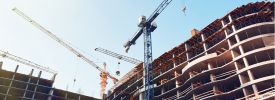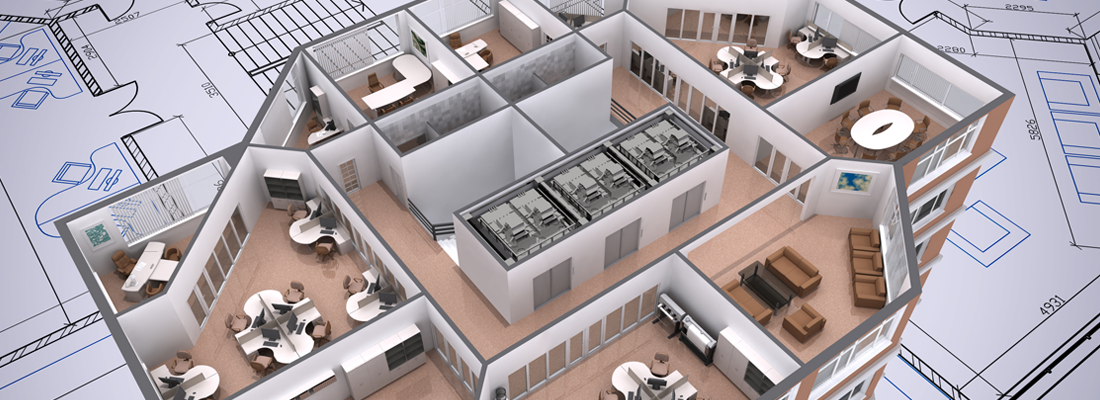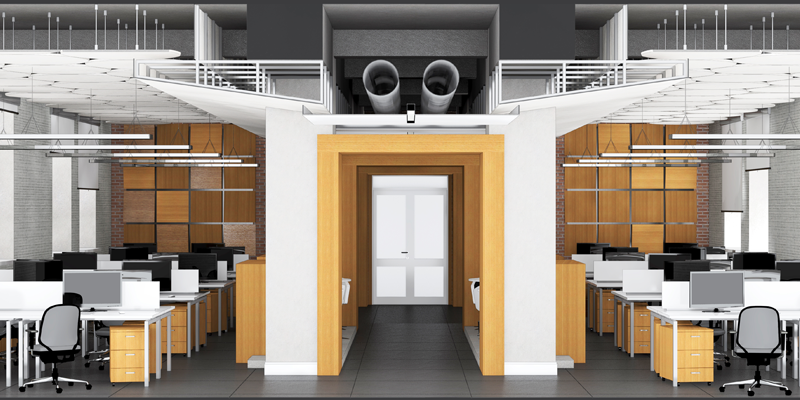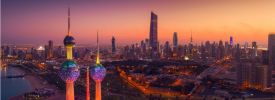
Reading time: 5 Minutes
In the past decade, offices have already begun to evolve from the dreary cubicles of workplaces past. But it’s only just begun, and the next ten years will see even more dramatic changes, says David Thame
The last thing the office of the future will look like is an office. A hotel, maybe. Perhaps an art gallery or a nice restaurant with gardens. But not like an office. Definitely not.
This is the conclusion some readers have drawn from the blue-sky thinking by MoreySmith, one of Europe’s leading design and architecture practices. The consultancy has unveiled a Workplace Futures Report(1) in partnership with The Future Laboratory, revealing what offices could look like by 2025.
The report identifies the three main social and demographic trends that will mean the workplace of tomorrow looks more like a home or hotel, than like the white-collar factory of today.
The first of these trends is data-based. Under pressure from wearable devices that record and analyse our daily routines and life patterns, workplaces will integrate with our personal technology to track our emotions and productivity.
Simultaneously, as working lives grow longer, a wider spread of age groups will be represented in the workplace – from starters in their 20s, to parents in their 30s and 40s and veterans in their 60s and 70s. Each group will need different kinds of spaces.
Third, and finally, sits the ubiquitous screen-based technology of our age. In the future, workplace design will aim to filter out digital distraction so that productivity grows without leaving workers feeling deprived of their devices.
The combined effect will be offices “that are no longer a bland desk in a dumb, indifferent building”, the report says. Instead they will become multi-generational live-work-eat-sleep hubs for men and women of all ages.
The report also predicts three ways that the modern workplace will adapt and evolve to reflect these trends. The first suggests that the workplace will become more like a living being in its own right (‘the sentient workplace’). The second explores an office that feels and behaves like a community destination (‘the hospitality workplace’). The third imagines a space designed for a workforce that ranges from twenty-somethings to seventy-somethings (‘the flat-age workplace’). Many – perhaps most – will be a combination of all three. Together they will transform the way we work.
The sentient workplace
The sentient workplace is probably the closest to becoming a part of today’s everyday workplace reality. While offices were once passive, hostile places that forced workers to adapt to fit into them, the workplace of tomorrow will work the other way around. It will adapt itself to its occupants’ needs, and will be designed and built to incorporate thousands of sensors that interact with workers’ wearable devices and smartphones. “The result,” predicts the report, “will be a playground for personalisation, forming atmospheric bubbles around individual workers.”
MoreySmith says that apps that interact with the sentient workspace will be ubiquitous – not only to replace entrance cards and passes, but for greater worker satisfaction. This is already happening at Deloitte’s Edge building in Amsterdam, where an app controls parking, daily desk allocation, locker access and food ordering. Deloitte believes this has led to 60 per cent fewer absentees, a fourfold increase in job applications and a substantial increase in talent retention.
The hospitality workplace
By the mid to late 2020s the hospitality workplace will also be a routine part of our working life, MoreySmith claims. Instead of the heavily patrolled entrance and strictly staff-only feel of today’s offices, the hospitality workplace will mix public and private spaces in a happy, relaxed blend. Workplaces will include public restaurants and cafes, rooftop terraces, art galleries, barber shops, nail bars, and even hotels, as the workplace enters the sharing economy.
New office amenities will matter, providing variety and release from routine. In Dublin, both California-based software house Workday and San Francisco-based Dropbox have already introduced well-equipped music rooms. The Dropbox music suite is a cross between a recording studio and a smoky jazz club – not what you normally find in an office block(2).
According to psychologist Michael Corballis, quoted in the MoreySmith report, these new workplaces will help us by providing the right kinds of distraction. “In adapting to a complex world, we need to escape the here and now, consider possible futures, mull over past mistakes and understand how other people’s minds work,” he says.
The flat-age workplace
With life expectancy growing, and working life extending into the 60s and 70s, the workplace of the future will be populated by several generations.
By the late 2020s the last of the baby boomers will be rubbing shoulders with the dominant Millennials and the digitally-native Generation Z in a mix that will mean soundproofed spaces for those whose patience with youthful hubbub is low, and mentor pods to help pass on information from the older to the younger, and vice versa.
Diversity incubators – spaces with a strong advocacy agenda, helping people into unfamiliar or challenging areas of work(3) – will become mainstream, says the report.
The needs of women are particularly important in the flat-age workplace – driving a change of emphasis and of amenities. Sound-proofed crèches, baby-feeding facilities and buggy and scooter parking are all being added to new office schemes, along with wellbeing rooms and gathering spaces.
Choose your tribe
While top interior designers and space-planners acknowledge the findings of the MoreySmith report, many say it understates one key part of the workplace of tomorrow: the tribal way human beings think.
Atul Bansal is co-founder at the Sheila Bird Group, and the designer credited with creating the new style of Manchester office space: sleek, clean, colourful and packed with stimulation. He says the workplace of the future may be hard to pin down.
“Workplace design ultimately comes down to tribes,” he says. “We’re all in tribes of various kinds, and we all want to feel surrounded by the rest of our tribe – be it our colleagues, our industry or our wider network.”
“That’s why community is the key to the office,” he adds. “You need to focus on the people inside the workspace, and the people outside the workspace, and how they relate to each other through the amenities and design.”
Unfortunately, he suggests, this isn’t something that can be easily touched or felt. “The tribe is a transient and truly agile thing, and catching it is like trying to catch a butterfly,” he says.
So, will the tribal workplace be the next big innovation, changing the face of offices in the years after 2025? There’s only one answer to that: set your workplace atmosphere app to ‘cool’, then wait and see.
David Thame has been writing on commercial property for 30 years and today appears regularly in British titles such as Estates Gazette, Manchester Evening News, ShD Logistics and US-based real estate website bisnow.com
Sources:
(1) http://www.worktechacademy.com/content/uploads/2018/02/The-Future-of-the-Workplace-Report-Morey-Smith-and-The-Future-Laboratory.pdf
(2) https://www.bisnow.com/dublin/news/office/funky-89352
(3) http://dsq-sds.org/article/view/6099/4819



